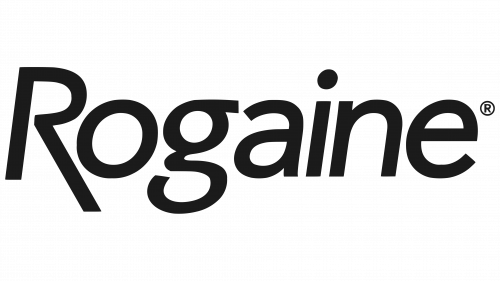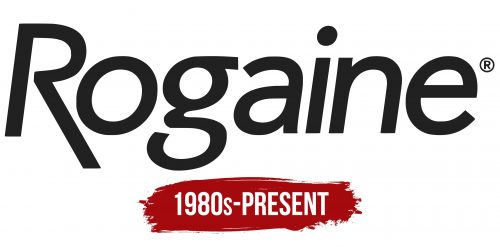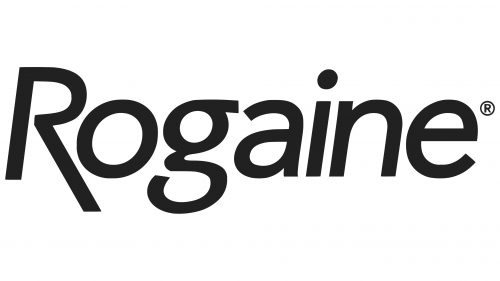The Rogaine logo conveys professionalism and confidence. Its elements resemble strong, resilient hair capable of withstanding any challenge. The rich, dark color symbolizes youth and healthy pigmentation, associating vitality and well-being.
Rogaine: Brand overview
The origins of Rogaine started in the 1970s when Upjohn, a later division of Pfizer, was studying minoxidil, a medication used to treat high blood pressure. During clinical trials, unexpected adverse effects were found: some patients developed hair. As a result of this unintentional discovery, minoxidil was created as a hair loss remedy.
In the 1980s, Upjohn began conducting extensive studies on minoxidil as a possible therapy for hair loss. The company conducted several research trials to verify the medication’s safety and effectiveness in promoting hair growth.
The FDA in the United States authorized minoxidil as a treatment for male pattern baldness in 1988. The medication was first made available as a 2% topical solution under the brand name Rogaine. At the time, it was the first and only androgenetic alopecia (hereditary hair loss) medication approved by the FDA.
Initially, the product was restricted to those with prescriptions. Nonetheless, because it gave millions of men experiencing hair loss hope, demand for it increased quickly.
The FDA’s 1991 approval of the product for female use greatly increased its potential market. Further clinical research demonstrating minoxidil’s efficacy in treating female hair loss was the foundation for this decision.
An important turning point came in 1996 when the FDA authorized over-the-counter selling. This choice increased customer accessibility, enabling the corporation to increase marketing expenditures.
In 1997, a more potent 5% product version was released for males. With even greater efficacy in promoting hair growth, this updated version cemented its leadership in the hair loss treatment industry.
When Johnson & Johnson purchased the rights to the product from Pharmacia & Upjohn (created when Upjohn merged with another pharmaceutical company) in 1998, a big shift took place. Thanks to this acquisition, the development and marketing of the brand now had more opportunities.
Early in the new millennium, the company continued to innovate by launching new product variations, such as a foam that absorbed more quickly than the conventional solution and was simpler to apply.
The year 2006 saw the introduction of the 5% foam for men, and because of its efficiency and ease of use, it immediately gained popularity.
In the 2010s, the company increased the variety of products in its lineup by launching customized formulas for various hair types and hair loss phases. The corporation has strengthened its educational programs to increase public understanding of the causes of hair loss and possible treatments.
A 5% foam formula exclusively offered to males was made available to ladies in 2011. Clinical research demonstrating the greater concentration of minoxidil’s efficacy for female hair loss sufferers was the foundation for this breakthrough. Alongside the product, a marketing push was launched to raise awareness of women’s hair loss issues and available remedies.
In 2013, the company added specialty shampoos and conditioners to its lineup to improve the effects of its main product. These products provide a thorough approach to hair care because they were specifically designed to meet the demands of minoxidil users’ hair and scalp.
2015 saw the introduction of Precision Foam, a cutting-edge product featuring a refined applicator for more accurate foam application. This advancement addressed consumer requests for a more practical and efficient application procedure. The new applicator reduced contact between the foam and the face and neck by applying the foam specifically to trouble spots.
The business started growing its online presence in 2017. The company introduced a customized hair loss treatment program online. This website gave consumers personalized advice on how to utilize the product according to their unique symptoms and stage of hair loss. A mobile app was created to assist consumers in monitoring their treatment progress and getting reminders regarding product applications.
2019 saw a large increase in funding for scientific research. The company launched numerous new clinical trials to investigate the long-term consequences of minoxidil use and its potential utility for treating additional alopecia. The objective of these investigations was to fortify the brand’s scientific foundation and create fresh avenues for the creation of inventive merchandise.
2020 saw the launch of a new product line aimed at younger users. This range featured therapies to prevent hair loss for those just starting to see the first indications of hair thinning. The products featured milder formulas and came with teaching papers emphasizing the value of preventing hair loss early on.
In 2021, the “Complete Hair Care System” was introduced. This system came with a specially made shampoo, conditioner, and scalp serum in addition to the standard minoxidil solution or foam. The all-encompassing strategy was developed to enhance general scalp health and establish ideal circumstances for hair growth.
In 2023, a novel product, powdered minoxidil for scalp application, was released. This new form’s main goals were to provide more accurate dosing and convenience, particularly for customers with long hair. The product was well-liked immediately by consumers who appreciated its secrecy and simplicity of usage.
In addition, the business increased its partnerships with eminent trichologists and academic institutions, participating in clinical trials and funding scholarly investigations into alopecia treatment.
Meaning and History
What is Rogaine?
It is a well-known brand of hair growth products used mainly to fight baldness in men and women. Its active ingredient is minoxidil, a drug that has been clinically proven to help regrow hair and slow hair loss in many people. It is sold over the counter in various forms, including foams and liquid solutions, and is usually applied directly to the scalp. The brand offers different strengths and formulations for men and women, catering to the hair loss characteristics of each gender. It has established itself as a market leader in hair loss products and one of the most effective over-the-counter products. The product is designed for long-term use, and users often see results after just a few months of constant use. While it is ineffective for all hair loss, it has helped many people regain their confidence by promoting growth and supporting existing hair.
1980s – today
Creating the “Rogaine” logo is closely tied to the company’s development and introducing innovative hair care solutions to the market. In the 1980s, as the active development and promotion of hair restoration products began, a need arose to create an emblem that would reflect the company’s mission—to help people combat hair loss and regain their confidence.
The designers who worked on the visual identity paid special attention to ensuring the logo conveyed the brand’s core message. A key focus was to create a logo that would be easily associated with the main product and inspire trust in consumers. The simple yet expressive font and the symbolism of the lines made the “Rogaine” emblem a recognizable and effective tool in the company’s marketing strategy.
The logo successfully combines simplicity and symbolism, making it memorable. It is rendered in black, symbolizing strength, reliability, and stability. The black color also emphasizes the seriousness and professionalism of a brand leader in the hair loss treatment market for over thirty years.
The font features thin, flowing lines that add lightness and elegance. These curves resemble wavy hair, highlighting the connection to the brand’s core product—hair restoration treatments. The elongated leg of the letter “R” stands out among the other elements, symbolizing the process of hair regrowth and visually demonstrating what the product promises.
Despite their thinness, the lines convey a sense of strength and resilience. This design element underscores the brand’s confidence in its products’ effectiveness and ability to address hair loss problems.





